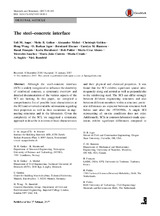Mostrar el registro sencillo del ítem
The steel concrete interface
| dc.contributor.author | Angst, Ueli M. | |
| dc.contributor.author | Geiker, Mette R. | |
| dc.contributor.author | Michel, Alexander | |
| dc.contributor.author | Gehlen, Christoph | |
| dc.contributor.author | Wong, Hong | |
| dc.contributor.author | Isgor. O. Burkan | |
| dc.contributor.author | Elsener. Bernhard | |
| dc.contributor.author | Hansson, Carolyn M. | |
| dc.contributor.author | Francois, Raoul | |
| dc.contributor.author | Hornbostel. Karla | |
| dc.contributor.author | Polder. Rob | |
| dc.contributor.author | Alonso, María Cruz | |
| dc.contributor.author | Sánchez Moreno, Mercedes | |
| dc.contributor.author | Correia. Maria Joao | |
| dc.contributor.author | Criado, María | |
| dc.contributor.author | Sagüés, A. | |
| dc.contributor.author | Buenfeld, Nick | |
| dc.date.accessioned | 2024-02-07T07:07:33Z | |
| dc.date.available | 2024-02-07T07:07:33Z | |
| dc.date.issued | 2017 | |
| dc.identifier.uri | http://hdl.handle.net/10396/27202 | |
| dc.description.abstract | Although the steel–concrete interface (SCI) is widely recognized to influence the durability of reinforced concrete, a systematic overview and detailed documentation of the various aspects of the SCI are lacking. In this paper, we compiled a comprehensive list of possible local characteristics at the SCI and reviewed available information regarding their properties as well as their occurrence in engineering structures and in the laboratory. Given the complexity of the SCI, we suggested a systematic approach to describe it in terms of local characteristics and their physical and chemical properties. It was found that the SCI exhibits significant spatial inhomogeneity along and around as well as perpendicular to the reinforcing steel. The SCI can differ strongly between different engineering structures and also between different members within a structure; particular differences are expected between structures built before and after the 1970/1980s. A single SCI representing all on-site conditions does not exist. Additionally, SCIs in common laboratory-made specimens exhibit significant differences compared to engineering structures. Thus, results from laboratory studies and from practical experience should be applied to engineering structures with caution. Finally, recommendations for further research are made. | es_ES |
| dc.format.mimetype | application/pdf | es_ES |
| dc.language.iso | spa | es_ES |
| dc.rights | https://creativecommons.org/licenses/by/4.0/ | es_ES |
| dc.source | Angst, U.M., Geiker, M.R., Michel, A. et al. The steel–concrete interface. Mater Struct 50, 143 (2017). https://doi.org/10.1617/s11527-017-1010-1 | es_ES |
| dc.subject | Steel–concrete interface, Interfacial transition zone, Durability, Corrosion, Inhomogeneity, Variability | es_ES |
| dc.subject | Interfacial transition zone | |
| dc.subject | Durability | |
| dc.subject | Corrosion | |
| dc.subject | Inhomogeneity | |
| dc.subject | Variability | |
| dc.title | The steel concrete interface | es_ES |
| dc.type | info:eu-repo/semantics/article | es_ES |
| dc.relation.publisherversion | https://doi.org/10.1617/s11527-017-1010-1 | |
| dc.rights.accessRights | info:eu-repo/semantics/openAccess | es_ES |

